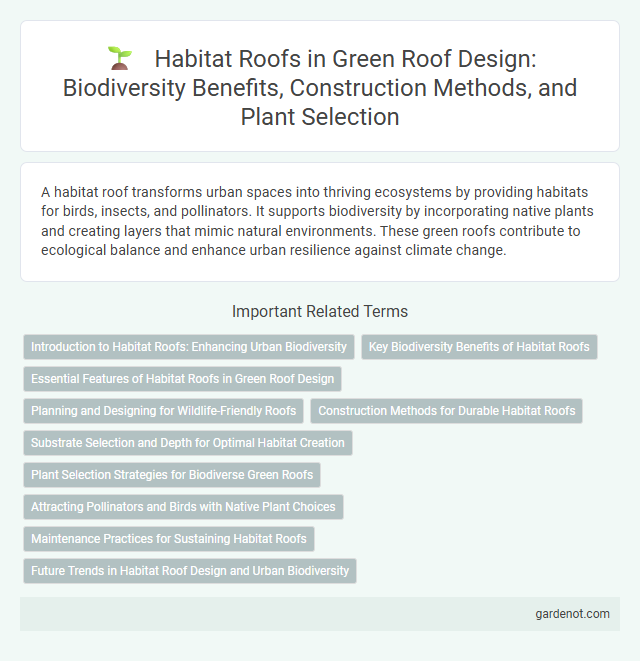A habitat roof transforms urban spaces into thriving ecosystems by providing habitats for birds, insects, and pollinators. It supports biodiversity by incorporating native plants and creating layers that mimic natural environments. These green roofs contribute to ecological balance and enhance urban resilience against climate change.
Introduction to Habitat Roofs: Enhancing Urban Biodiversity
Habitat roofs are specially designed green roofs that prioritize creating diverse ecosystems to support urban wildlife such as birds, bees, and butterflies. By incorporating native plants, varied vegetation layers, and microhabitats, habitat roofs increase urban biodiversity and mitigate the effects of habitat loss in cities. These sustainable roof systems improve air quality, reduce urban heat islands, and promote ecological balance within dense metropolitan environments.
Key Biodiversity Benefits of Habitat Roofs
Habitat roofs significantly enhance urban biodiversity by providing critical habitats for pollinators, birds, and native plant species, promoting ecological networks in dense city environments. These green roofs support diverse flora that improve air quality and increase the resilience of local ecosystems against climate change. By integrating habitat roofs, cities create essential green corridors that sustain pollination and wildlife migration, fostering overall biodiversity conservation.
Essential Features of Habitat Roofs in Green Roof Design
Habitat roofs incorporate essential features such as diverse native vegetation, layered substrates for water retention, and integrated habitats for local wildlife, promoting biodiversity and ecological balance. Their structural design supports resilient ecosystems by enhancing air quality and reducing urban heat island effects. These roofs contribute significantly to sustainable building practices by optimizing stormwater management and providing natural insulation.
Planning and Designing for Wildlife-Friendly Roofs
Planning a wildlife-friendly habitat roof requires careful selection of native plant species and structural diversity to support various pollinators, birds, and insects. Designing layers of vegetation with varying heights and microhabitats enhances biodiversity and creates sustainable ecological niches. Incorporating water features and nesting sites further encourages wildlife habitation and promotes urban resilience.
Construction Methods for Durable Habitat Roofs
Habitat roof construction employs layered waterproof membranes, high-load-bearing substrates, and root barriers to ensure durability and longevity. Utilizing lightweight, moisture-retentive soil mixes promotes healthy vegetation growth without compromising structural integrity. Integrating drainage systems and thermal insulation enhances habitat stability and energy efficiency, supporting sustainable urban ecosystems.
Substrate Selection and Depth for Optimal Habitat Creation
Selecting the appropriate substrate for a green roof habitat involves balancing drainage, nutrient availability, and moisture retention to support diverse plant and animal species. Optimal substrate depth typically ranges from 10 to 20 centimeters for sedum-based roofs, while more complex habitats with grasses or shrubs may require depths exceeding 30 centimeters to accommodate root systems and provide shelter. Proper substrate composition and depth are critical for promoting biodiversity, improving thermal regulation, and enhancing stormwater management on green roofs.
Plant Selection Strategies for Biodiverse Green Roofs
Plant selection strategies for habitat roofs emphasize native, drought-tolerant species to foster biodiversity and support local wildlife. Incorporating a mix of flowering perennials, grasses, and succulents enhances habitat complexity, attracts pollinators, and improves ecological resilience. Selecting plants with varied rooting depths and growth habits optimizes water retention and microhabitats on green roofs.
Attracting Pollinators and Birds with Native Plant Choices
Habitat roofs featuring native plants create essential ecosystems that attract pollinators like bees, butterflies, and hummingbirds by providing abundant nectar and pollen sources. Selecting native wildflowers, grasses, and shrubs enhances biodiversity, supports local wildlife populations, and improves urban ecological health. These carefully chosen plant species also offer shelter and nesting materials for birds, fostering a balanced habitat in city environments.
Maintenance Practices for Sustaining Habitat Roofs
Regular inspection and targeted weeding prevent invasive species from overwhelming habitat roofs, ensuring native plants thrive. Irrigation management tailored to native vegetation supports resilience during drought periods, minimizing water use while sustaining plant health. Seasonal pruning and debris removal maintain optimal growing conditions and enhance biodiversity on habitat roofs.
Future Trends in Habitat Roof Design and Urban Biodiversity
Habitat roof designs are evolving to incorporate advanced materials and modular systems that enhance urban biodiversity by providing diverse habitats for native flora and fauna. Innovations such as sensor-driven irrigation and climate-adaptive green layers optimize plant health and support pollinators, birds, and beneficial insects, promoting ecosystem resilience. Future trends emphasize integration with smart city infrastructure, enabling real-time environmental monitoring and contributing to sustainable urban development.
Habitat roof Infographic

 gardenot.com
gardenot.com